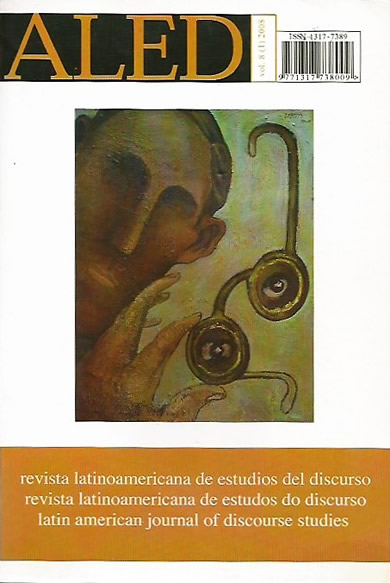Estratégias de (im)polidez em interações acadêmicas virtuais
Keywords:
(im)politeness. discourse domain. academic discourse.Abstract
This paper aims to discuss the concept of politeness from an interactional perspective, using, as a basis for reflection, data from two academic genres, chat lessons and discussion lists. Opposing to the common posture derived from seminal works on the theme, we postulate that the analysis should not be limited to the utterance level. It should consider the behavior of those who are interacting, i.e. it isn’t the utterance that is (im)polite, but the people who interpret the utterances as having differing degrees of politeness. This means that it is vital to try to identify the factors that influence the dynamic perceptions of the interlocutors about the phenomenon
Downloads
References
BATESON, G. (1972). ‘A theory of play and fantasy?’, in: G. Bateson Steps to anEcology of Mind, pp. 177-193. New York: Chandler.
BROWN, P. & LEVINSON, S. (1987). Politeness. Some Universals in Language Usage.Cambridge: CUP.
FRASER, B. & NOLAN, W. (1981). ‘The association of deference with linguisticforma’, in: J. Walters (ed.) The Sociolinguistics of Deference and Politeness,pp. 93 - 109. The Hague: Mouton.
GOFFMAN, E. (1974). Frame Analysis. New York: Harper & Row.GUMPERZ, J.J. (1977). ‘Sociocultural knowledge in conversation inference’, in:M. Saille-Troike (ed.), Linguistics and Anthropology. Georgetown Round Table on Languages and Linguistics, pp.191-211. Washington, DC: George-town University Press.GU, Y. (1990). ‘Politeness phenomena in modern Chinese’, Journal of Pragma-tics, 14 (2): 237 ”“ 257.
IDE, S. (1993). ‘Formal forms and discernement: two neglected aspects of uni-versals of linguistics politeness’, Multilingua, 8 (2/3): 223 ”“ 248.
LEECH, G. (1983). Principles of Pragmatics. London: Longman.LEECH, G. (2005). ‘Politeness: Is there an East_West Divide?’, Journal of ForeignLanguage, 6: 1004 ”“ 5139.
LOCHER, M. & WATTS, R. (2005). ‘Politenss theory and relational work’, Journalof Politeness Research, 1: 9 ”“ 33.
MAO, L.R. (1994). ‘Beyond politeness theory: “Face” revisited and renewed’,Journal of Pragmatics, 21: 403 ”“ 426.
SPENCER-OATEY, H. (2000) ‘Rapport management: A framework for analysis’,in: H. Spencer-Oatey (ed.) Culturally Speaking. Managing Rapport throughTalk across Cultures, pp. 11 ”“ 46. London: Continuum.
SPENCER-OATEY, H. (2005). ‘(Im)politeness, face and perceptions of rapport:Unpackaging their bases and interrelationships`, Journal of PolitenessResearch, 1: 95 ”“119.
TANNEN, D. e WALLAT, C. (1987). ‘Interactive frames and knowledge schemas ininteraction: Examples from a medical examination / interview’, Social Psychology Quaterly 50, 2: 205-216.WATTS, R. (2003). Politeness. Cambridge: Cambridge University Press.
WIERZBICKA, A. ([1991] 2003). Cross-cultural Pragmatics: the Semantics of Human Interaction. Berlin: Mouton.
Downloads
Published
How to Cite
Issue
Section
License

This work is licensed under a Creative Commons Attribution-NonCommercial-NoDerivatives 4.0 International License.
The authors retain the copyright and guarantee RALED the right to be the first publication of the work as well as a Creative Commons Attribution License that allows others to share the work with recognition of authorship and the initial publication in this journal.




